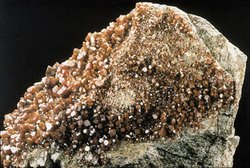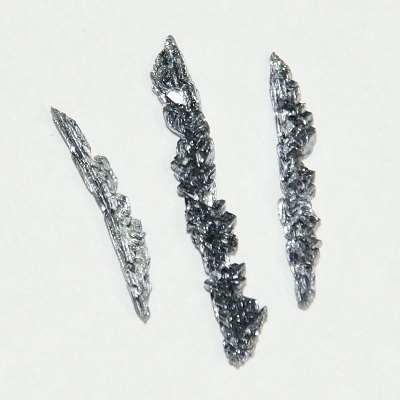Vanadium
Vanadium is a soft, silver-gray metallic element. Its atomic number is 23 and symbol is V. Two different scientists discovered it. However, they were not working together and even lived across the globe from one another. In 1803, Andres Manuel del Rio, a Spanish mineralogist working in Mexico City, first discovered a material he called brown lead. He later renamed this compound erythronium meaning red, a reference that this material turned red when heated. In 1831, a Swedish chemist named Nils Gabriel Sefstrom isolated a new material that he named vanadium in honor of the goddess of beauty and fertility, Vanadis. Ultimately, the name vanadium was chosen.

Henry Roscoe isolated metallic vanadium in 1867. He took vanadium chloride (VCl3) and reduced it with hydrogen to form vanadium metal and hydrochloric acid (HCl).
There is a minor amount of vanadium in the human body, however it is not known to serve any biological function. It is an interesting fact that vanadium is an essential element to ascidians, also known as sea squirts. These species concentrate vanadium in their bodies to a level one million times higher than the concentration of vanadium in seawater.
Contents
Name
| Previous Element: Titanium Next Element: Chromium |
| |
| Physical Properties | ||
|---|---|---|
| Color | bright white | |
| Phase at Room Temp. | solid | |
| Density (g/cm3) | 6.11 | |
| Hardness (Mohs) | --- | |
|
Melting Point (K) |
2163.2 | |
|
Boiling Point (K) |
3623 | |
| Heat of Fusion (kJ/mol) | 17.6 | |
| Heat of Vaporization (kJ/mol) | 459 | |
| Heat of Atomization (kJ/mol) | 514 | |
| Thermal Conductivity (J/m sec K) | 30.7 | |
| Electrical Conductivity (1/mohm cm) | 39.37 | |
| Source | U, Pb vanadates (misc) | |
| Atomic Properties | ||
| Electron Configuration | [Ar]4s23d3 | |
|
Number of Isotopes |
27 (2 natural) | |
| Electron Affinity (kJ/mol) | 50.7 | |
| First Ionization Energy (kJ/mol) | 650.3 | |
| Second Ionization Energy (kJ/mol) | 1413.5 | |
| Third Ionization Energy (kJ/mol) | 2828 | |
| Electronegativity | 1.63 | |
| Polarizability (Å3) | 12.4 | |
| Atomic Weight | 50.941 | |
| Atomic Volume (cm3/mol) | 8.3 | |
| Ionic Radius2- (pm) | --- | |
| Ionic Radius1- (pm) | --- | |
| Atomic Radius (pm) | 134 | |
| Ionic Radius1+ (pm) | --- | |
| Ionic Radius2+ (pm) | 93 | |
| Ionic Radius3+ (pm) | 78 | |
| Common Oxidation Numbers | +5 | |
| Other Oxid. Numbers | +1, +1, +2, +3, +4 | |
| Abundance | ||
| In Earth's Crust (mg/kg) | 1.20×102 | |
| In Earth's Ocean (mg/L) | 2.5×10-3 | |
| In Human Body (%) | 0.00% | |
| Regulatory / Health | ||
| CAS Number | 7440-62-2 | |
| OSHA Permissible Exposure Limit (PEL) | No limit | |
| OSHA PEL Vacated 1989 | No limit | |
|
NIOSH Recommended Exposure Limit |
No limit | |
|
Sources: |
||
Vanadium was named after Vanadis, the goddess of beauty in Scandinavian mythology. The name was given by Nils Gabriel Sefstrom. A very beautiful, deep red mineral, vanadinite, contains vanadium and was named after its vanadium content.
Sources
It is estimated that the presently known world resources (Natural resource quality) of vanadium total 63 million tons. There is no single mineral ore from which vanadium is recovered. However, it is found as a trace element in a number of different rock materials and is a by-product of other mining operations. Vanadium is found in magnetite (iron oxide) deposits that are also very rich in the element titanium. It is also found in bauxite (aluminum ore), rocks with high concentrations of phosphorous-containing minerals, and sandstones that have high uranium content. Vanadium is also recovered from carbon-rich deposits such as coal, oil shale, crude oil, and tar sands.
Vanadium resources in the United States, where it is usually associated with uranium ores in sandstones, are large enough to supply U.S. vanadium needs. However, it is often cheaper to import vanadium and ferrovanadium products. The ferrovanadium that is imported is purchased from Canada, China, the Czech Republic, South Africa, and other nations. The majority of vanadium pentoxide used in glass manufacturing is imported from South Africa.
Uses
Vanadium itself may be soft in its pure form, but when it is alloyed (that is, mixed) with other metals like iron, it hardens and strengthens them dramatically. Consequently, vanadium is used extensively to make alloys (mostly steel alloys) for tools and construction purposes. Most of the vanadium consumed is used for these applications. Specifically, vanadium is alloyed with iron to make carbon steel, high-strength low-alloy steel, full alloy steel, and tool steel. These hard, strong ferrovanadium alloys are used to make armor plating for military vehicles and other protective vehicles. It is also used to make car engine parts that must be very strong, such as piston rods and crank shafts. The steel “skeleton” or frames of high-rise buildings and oil drilling platforms must be very strong to support the weight of the building and its contents; vanadium steel has the strength to support such massive weight.
Some vanadium is used in other industrial applications. For example, vanadium pentoxide (V2O5) is used production of glass and ceramics and as a chemical catalyst. (A catalyst is a substance that assists in and often speeds up chemical reactions but is not consumed in the chemical reaction.) Compounds of vanadium are used to dye fabrics.
Scientists have discovered that a mixture of the elements vanadium and gallium are useful in making superconductive magnets.
Substitutes and Alternative Sources
A number of other elements can be substituted for vanadium in the production of high-strength steel. These include columbium, molybdenum, titanium, and tungsten. Other metals can be used in place of vanadium as a chemical catalyst, including platinum and nickel.
Further Reading
- Common Minerals and Their Uses, Mineral Information Institute.
- More than 170 Mineral Photographs, Mineral Information Institute.
| Disclaimer: This article contains information that was originally published by the Mineral Information Institute. Topic editors and authors for the Encyclopedia of Earth have edited its content and added new information. The use of information from the Mineral Information Institute should not be construed as support for or endorsement by that organization for any new information added by EoE personnel, or for any editing of the original content. |
